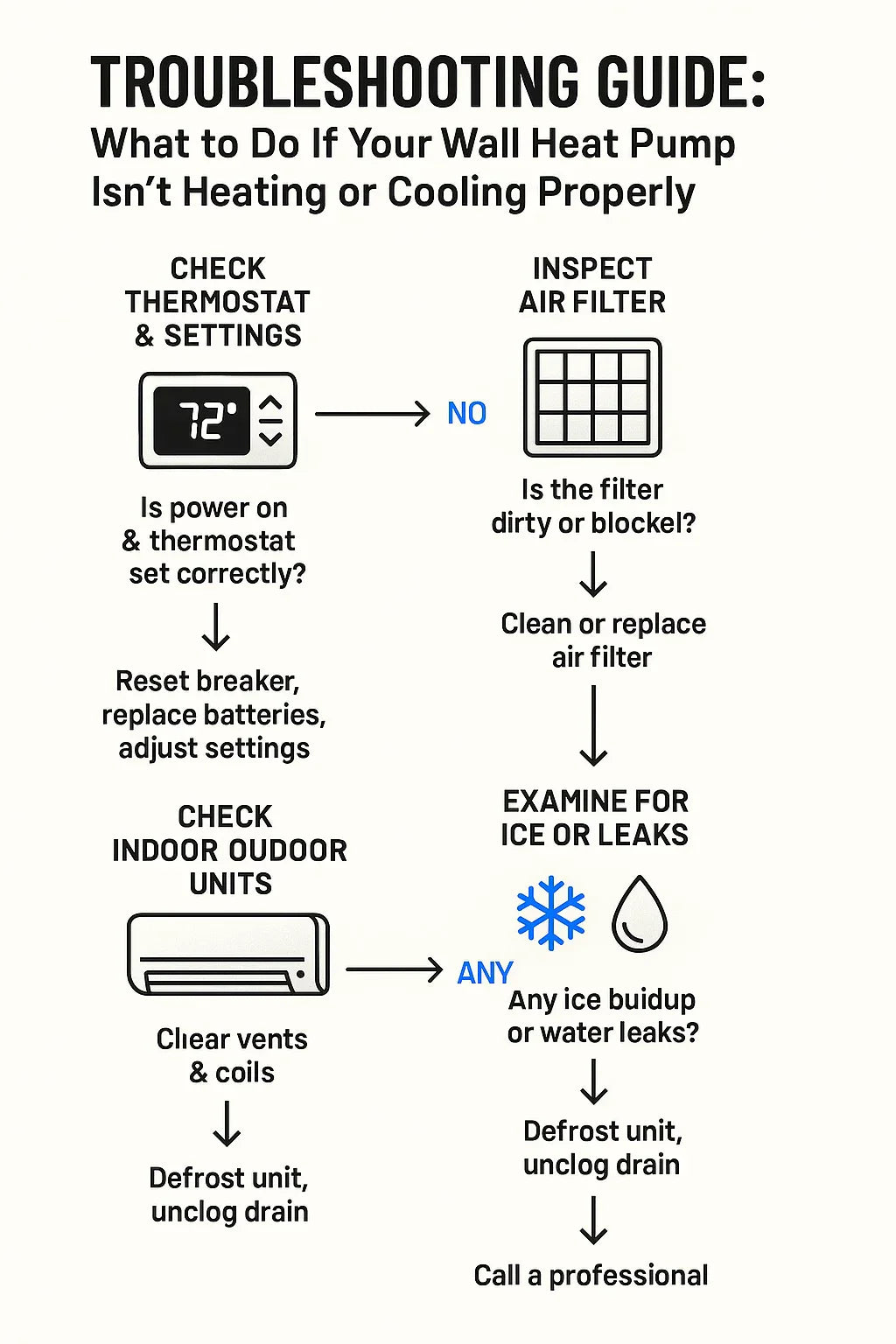Jake – I’ve been around enough HVAC issues to know half of them are fixable in under 10 minutes, if you know what to check first. The rest? You call a pro, but at least you won’t waste time (or money) on the obvious stuff.
Best Through The Wall Heat Pumps
☕ 1. Introduction — Don’t Panic Yet
I’ve lost count of the times friends have called saying, “Jake, my heat pump’s dead!”
Nine times out of ten, the fix was as simple as:
-
Cleaning a clogged filter
-
Changing a thermostat setting
-
Flipping a tripped breaker
Before you assume the worst, let’s walk through some DIY-friendly checks that can save you the cost of an unnecessary service call.
🔍 2. Step 1 — Check the Basics First
Why? Most “broken” heat pumps aren’t broken at all—they’re just set wrong or starved for airflow.
-
Thermostat Settings
-
Make sure it’s in HEAT mode if you want heat, and COOL mode if you want cooling.
-
Set the temperature at least 3–5°F above or below the current room temperature.
-
If your thermostat has a “fan only” mode, make sure it’s not on that by accident.
-
-
Breaker or Power Switch
-
Find your electrical panel and look for a tripped breaker.
-
Many wall units also have an exterior disconnect or switch—check that it’s on.
-
-
Remote Batteries
-
If you control your unit with a remote, dead or weak batteries can stop commands from registering.
-
📚 Reference: Common Heat Pump Problems
🧹 3. Step 2 — Check Airflow & Filters
A clogged filter is the #1 cause of weak heating or cooling.
-
How to Check: Remove the filter and hold it up to the light. If you can’t see light through it, it’s dirty.
-
Fix: Wash or replace the filter (follow your manufacturer’s instructions).
-
Bonus Tip: While the filter is out, vacuum the intake grille to remove dust and pet hair.
Blocked airflow means:
-
Poor temperature control
-
Higher energy bills
-
Risk of freezing the coil
📚 Reference: ENERGY STAR – Heat Pump Efficiency Tips
🌬 4. Step 3 — Check for Indoor or Outdoor Blockages
Indoor:
-
Furniture or curtains blocking the intake or supply vents can choke the system.
Outdoor:
-
Through-the-wall units vent outdoors. Check the exterior grille for:
-
Leaves
-
Lint (if near a dryer vent)
-
Bird nests or debris
-
Clear obstructions with a soft brush or vacuum. Make sure airflow is unobstructed at least 2 feet around the grille.
🌀 5. Step 4 — Inspect the Coil Condition
Dirty coils = reduced heat exchange.
-
Indoor Evaporator Coil: Remove the front cover, look for dust or grime.
-
Outdoor Condenser Coil: Check the exterior fins for dirt buildup.
Fix: Use a coil cleaner spray (no-rinse type) and a soft brush. Never use a pressure washer—it will bend fins.
📚 Reference: Family Handyman – HVAC Maintenance
💧 6. Step 5 — Check the Drainage System
If your unit’s drain pan or line is clogged:
-
Water can back up and affect airflow.
-
In cooling mode, excess moisture can freeze on the coil.
Fix:
-
Find the drain outlet.
-
Use a pipe cleaner, brush, or shop vac to clear clogs.
-
Pour a 50/50 vinegar-water mix through the drain to prevent algae.
❄ 7. Step 6 — Is It Freezing Up?
In cooling mode, ice on the indoor coil means:
-
Low airflow (dirty filter, blocked vent) or
-
Low refrigerant (requires a pro)
In heating mode, frost on the outdoor coil is normal—it should melt during defrost cycles. If it doesn’t, there may be a defrost control issue.
📚 Reference: HVAC.com – Heat Pump Troubleshooting
⚡ 8. Step 7 — Check for Electrical Issues
-
Look for loose wiring connections if you’re comfortable doing so (power OFF first).
-
Burnt smells or scorch marks mean call a pro immediately.
-
Faulty capacitors or control boards require replacement by a technician.
🧊 9. Step 8 — Could It Be Refrigerant?
Low refrigerant = poor heating/cooling + possible hissing sound.
Important:
Do NOT attempt to add refrigerant yourself. It’s illegal without certification and dangerous. Call an EPA-licensed HVAC tech.
📚 Reference: This Old House – Heat Pump Repair Basics
🚨 10. Step 9 — When to Call a Pro Immediately
-
Electrical burning smell
-
Loud banging or grinding noises
-
No heat in freezing weather
-
No cooling in extreme heat
-
Water leaking inside the home
-
Unit trips breaker repeatedly
🗂 11. Jake’s Quick Troubleshooting Table
| Symptom | Likely Cause | DIY Fix? |
|---|---|---|
| Weak airflow | Dirty filter or coil | ✅ Clean/replace |
| No heat/cool | Wrong mode or thermostat issue | ✅ Adjust settings |
| Water leaks | Clogged drain | ✅ Clear drain |
| Frost won’t melt | Defrost issue | ❌ Call pro |
| Loud banging | Fan or compressor issue | ❌ Call pro |
📆 12. How to Prevent Repeat Problems
-
Clean filter monthly during heavy use.
-
Deep-clean coils twice a year.
-
Keep outdoor grille clear year-round.
-
Schedule an annual pro check.
✅ 13. Jake’s Final Advice
Troubleshooting a wall heat pump isn’t about becoming an HVAC tech—it’s about ruling out the easy fixes first. You’ll either solve it yourself or know exactly what to tell the repair guy, saving you time and money.
In the Next Topic we will know more about: Can a Wall Heat Pump Cool or Heat Multiple Rooms? Layout & Circulation Hacks







